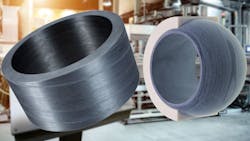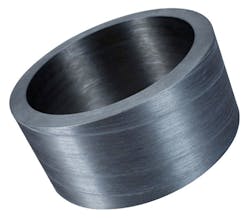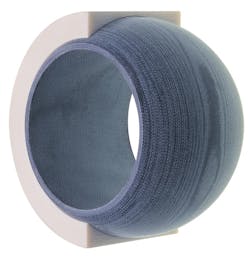Making the Case for Plastic Bearings
Let’s take a look at the advantages and disadvantages of different bearing materials.
Metal
The two primary types of metal bearings are plain and rolling element. Rolling element bearings use rollers or balls between two rings for motion with little resistance (friction). The roller’s shape affects the amount of friction created and load that can be carried.
For high-speed rotary applications, metal rolling-element bearings are the best choice. Plain bearings, both metal and plastic, cannot properly distribute the heat generated in high-speed situations, which can lead to bearing failure.
Plain metal bearings, also called sleeve bearings, bushes or bushings, are cylindrical and contain no moving parts. They are often used as flanged bearings or thrust washers for radial and light axial loads, as well as slide bearings or wear plates for sliding applications.
The most popular metal for plain bearings is bronze, although steel and iron are options. They almost always require lubrication, which adds to the maintenance requirements. They also corrode when exposed to water or chemicals, such as acids, alkalis and salts.
Plastics
Some designers still believe metal bearings take more load than polymer-based bearings. In certain applications, metal is the appropriate choice, but not always. Many of today’s thermoplastic and thermoset bearings sustain high pressure loads, and nearly all are superior to metal when it comes to weight, necessary maintenance and corrosion resistance.
There are two types of polymer-based bearings: thermoplastics and thermoset plastics.
To make thermoplastic bearings, pellets are heated and formed into shapes when that can then be machined to improve tolerances and performance.
Thermoplastic base materials include:
- POM (polyoxymethylene)
- PA (polyamide)
- PEEK (polyether ether ketone)
- PI (polyimide)
- PTFE (polytetrafluoroethylene)
Thermoset plastics begin as a base resin. After a catalyst is added and heat applied, a chemical reaction stiffens the plastic. Often, fabric reinforcements are added to the resin to improves strength and durability.
Thermoset plastics include:
- Ester (e.g., polyester)
- Epoxy
- Phenolic
Unlike thermoset plastics, thermoplastics can be remelted and reused. This means less waste during manufacturing process, which lowers the cost of bearings. Although some thermoplastics, such as the PI polymers commonly used as bushings for jet engines, resist temperatures up to 600°F, re-melting lowers some performance characteristics and prevent some from being used in high temperature applications.
Solid lubricants can be added to thermoplastics and thermosets during production, creating bearings with extremely low friction coefficients.
Selecting Bearing Materials
High-speed rotary applications call for metal roller bearings because plastic bearings can’t take the heat. However, plastic bearings are a better choice than plain metal bearings in a variety of applications due to their benefits:
- Less maintenance. Plastic bearings eliminate the need for external lubrication, since it can be built into the bearing during manufacturing. This reduces the work needed to clean and store machines, such as harvesters and tractors, Metal bearings on such equipment must have each pivot point cleaned and greased periodically throughout the season and again before winter storage. This also virtually eliminates buildup of dirt and debris that semi-solid and liquid lubricants can attract.
- Greater chemical resistance. Many polymers are chemically inert, which makes them immune to corrosion even in harsh conditions. For example, salts, alkalis and acids that equipment can be exposed to in oil and gas applications degrade standard metal bearings. PTFE and PEEK bearings can withstand those substances.
- Reduced weight. Thermoplastic and thermoset bearings are lighter than their bronze counterparts. In assemblies with many bearings, changing from bronze to a polymer-based bearing significantly reduces the assemblies’ weight and the power required for operation.
- Better dampening. Polymer-based bearings are effective at absorbing vibrations. So, replacing metal bearings with plastic ones can make equipment run quieter.
- Reduced cost of ownership. The total cost of ownership is virtually always lower with plastic bearings, which are maintenance-free and help extend equipment life by reducing friction.
There are two main considerations for designers when specifying polymer-based bearings: the required tolerance and the running clearance. In general, metal bearings can be machined to tighter tolerances. This is especially important for use in high-speed rotary applications. The running clearance (i.e., the space between the shaft and bearing) can change more with polymer bearings that expand more than metal when heated. This can prevent movement and cause the bearing to seize on the shaft. Therefore, it is important to consider the thermal effect of the environment on operations.
Understanding the properties of polymer-based bearings will let engineers use them in the settings where they excel, including harsh chemical environments, applications in which weight reduction plays a significant factor, and applications where maintenance costs could greatly affect the TCO of an expensive machine, such as a harvester or tractor.
Are Plastic Bearings Fit for High-Load Applications?
There’s a common belief that metal always bears more load than plastic. The truth is that some polymers outperform some metallic bearings at bearing high loads. For example, a typical bronze bearing has a pressure rating of about 40,0000 lb/in2. A thermoset plastic bearing, which is 1/7th the weight, withstands 45,0000 lb/in2, a 10% increase. In some applications, thermoplastic bearings withstand nearly 200,000 lb/in2 before failing.
Tom Zozokos is product line director and Michael Cook is a fluid power technical specialist at Trelleborg Sealing Solutions.


